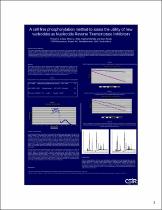 ResearchSpace
ResearchSpace
Cell free phosphorylation method to assess the utility of new nucleotides as nucleoside reserve transcriptase inhibitors
JavaScript is disabled for your browser. Some features of this site may not work without it.
- ResearchSpace
- →
- Research Publications/Outputs
- →
- Conference Publications
- →
- View Item
| dc.contributor.author |
Lebea, Phiyani J

|
|
| dc.contributor.author |
Bode, ML

|
|
| dc.contributor.author |
Mathiba, K

|
|
| dc.contributor.author |
Brady, D

|
|
| dc.date.accessioned | 2007-08-03T12:47:28Z | |
| dc.date.available | 2007-08-03T12:47:28Z | |
| dc.date.issued | 2007-06 | |
| dc.identifier.citation | Lebea, P.J. et al. 2007. Cell free phosphorylation method to assess the utility of new nucleotides as nucleoside reserve transcriptase inhibitors. 3rd South African AIDS Conference. Durban, South Africa, 5-8 June 2007, pp 1 | en |
| dc.identifier.uri | http://hdl.handle.net/10204/1084 | |
| dc.description.abstract | The acyclic nucleoside phosphonates such as cidofovir, adefovir and tenofovir have proved to be effective in vitro (cell culture systems) and in vivo (animal models, clinical studies) against a wide variety of DNA virus and retrovirus infections. These phosphonates have an added advantage owing to their improved efficacy due to a rapid intracellular uptake of the prodrug resulting in an increased intracellular accumulation of the diphosphate product, which is the pharmacologically active metabolite. Different modifications and derivatives of phosphonates have been synthsised and different scales of potency have been described. However, the potency depends on the sactual phosphorylation of the prodrug in the cells of choice. In order for Nucleoside Reverse Transcriptase Inhibitors (NRTIs) of HIV-1 to exhibit activity, it is necessary that they be phosphorylated to their triphosphate form. In the case of anti-HIV agents this process is catalyzed by human nucleoside kinases. It is therefore imperative that newly designed inhibitors be recognised as substrates by human kinase enzymes. The objective was to set up an enzymatic assay as an alternative to the commonly used cell-based approach for assessing NRTI activity. This provides a means of monitoring the extent of substrate phosphorylation as well as RT inhibitory activity | en |
| dc.language.iso | en | en |
| dc.subject | Phosphorylation | en |
| dc.subject | SA-AIDS Conference, 5-8 June 2007 | en |
| dc.subject | Nucleoside reserve transcriptase inhibitors | en |
| dc.subject | Cell culture systems | en |
| dc.title | Cell free phosphorylation method to assess the utility of new nucleotides as nucleoside reserve transcriptase inhibitors | en |
| dc.type | Conference Presentation | en |
| dc.identifier.apacitation | Lebea, P. J., Bode, M., Mathiba, K., & Brady, D. (2007). Cell free phosphorylation method to assess the utility of new nucleotides as nucleoside reserve transcriptase inhibitors. http://hdl.handle.net/10204/1084 | en_ZA |
| dc.identifier.chicagocitation | Lebea, Phiyani J, ML Bode, K Mathiba, and D Brady. "Cell free phosphorylation method to assess the utility of new nucleotides as nucleoside reserve transcriptase inhibitors." (2007): http://hdl.handle.net/10204/1084 | en_ZA |
| dc.identifier.vancouvercitation | Lebea PJ, Bode M, Mathiba K, Brady D, Cell free phosphorylation method to assess the utility of new nucleotides as nucleoside reserve transcriptase inhibitors; 2007. http://hdl.handle.net/10204/1084 . | en_ZA |
| dc.identifier.ris | TY - Conference Presentation AU - Lebea, Phiyani J AU - Bode, ML AU - Mathiba, K AU - Brady, D AB - The acyclic nucleoside phosphonates such as cidofovir, adefovir and tenofovir have proved to be effective in vitro (cell culture systems) and in vivo (animal models, clinical studies) against a wide variety of DNA virus and retrovirus infections. These phosphonates have an added advantage owing to their improved efficacy due to a rapid intracellular uptake of the prodrug resulting in an increased intracellular accumulation of the diphosphate product, which is the pharmacologically active metabolite. Different modifications and derivatives of phosphonates have been synthsised and different scales of potency have been described. However, the potency depends on the sactual phosphorylation of the prodrug in the cells of choice. In order for Nucleoside Reverse Transcriptase Inhibitors (NRTIs) of HIV-1 to exhibit activity, it is necessary that they be phosphorylated to their triphosphate form. In the case of anti-HIV agents this process is catalyzed by human nucleoside kinases. It is therefore imperative that newly designed inhibitors be recognised as substrates by human kinase enzymes. The objective was to set up an enzymatic assay as an alternative to the commonly used cell-based approach for assessing NRTI activity. This provides a means of monitoring the extent of substrate phosphorylation as well as RT inhibitory activity DA - 2007-06 DB - ResearchSpace DP - CSIR KW - Phosphorylation KW - SA-AIDS Conference, 5-8 June 2007 KW - Nucleoside reserve transcriptase inhibitors KW - Cell culture systems LK - https://researchspace.csir.co.za PY - 2007 T1 - Cell free phosphorylation method to assess the utility of new nucleotides as nucleoside reserve transcriptase inhibitors TI - Cell free phosphorylation method to assess the utility of new nucleotides as nucleoside reserve transcriptase inhibitors UR - http://hdl.handle.net/10204/1084 ER - | en_ZA |





